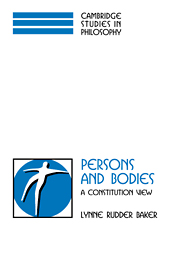Book contents
7 - The Coherence of the Idea of Material Constitution
Published online by Cambridge University Press: 05 June 2012
Summary
The approach to the material world in terms of constitution without identity has been subjected to a barrage of criticism. Some objections have been leveled at the very idea of constitution-without-identity; others have challenged the specific application of the idea of constitution- without-identity to the problem of persons and their bodies. In this chapter, I want to defend the idea of constitution-without-identity. In the next chapter, I want to defend the Constitution View of human persons and their bodies.
Some of the objections just refuse to take the general idea of constitution-without-identity seriously. For example, David Lewis speaks for many when he remarks, “It reeks of double-counting to say that here we have a dishpan, and we also have a dishpan-shaped bit of plastic that is just where the dishpan is. …” But this is just a bit of polemics. There is no double-counting; we count by sortals, and ‘piece of plastic’; is a different sortal from ‘dishpan.’ The “reek of double-counting” comes from Lewis's tendentious use of ‘dishpan-shaped’ to describe the piece of plastic. The less tendentious way to express what constitutionwithout- identity implies is to say: Here we have a dishpan constituted by an S-shaped piece of plastic, where ‘S-shaped’ is a more neutral expression denoting the actual shape of the piece of plastic. To see that Lewis's remark gets its bite from being amusing, consider a less amusing (and by now tired) example of a piece of sculpture constituted by a hunk of gold.
- Type
- Chapter
- Information
- Persons and BodiesA Constitution View, pp. 167 - 190Publisher: Cambridge University PressPrint publication year: 2000



